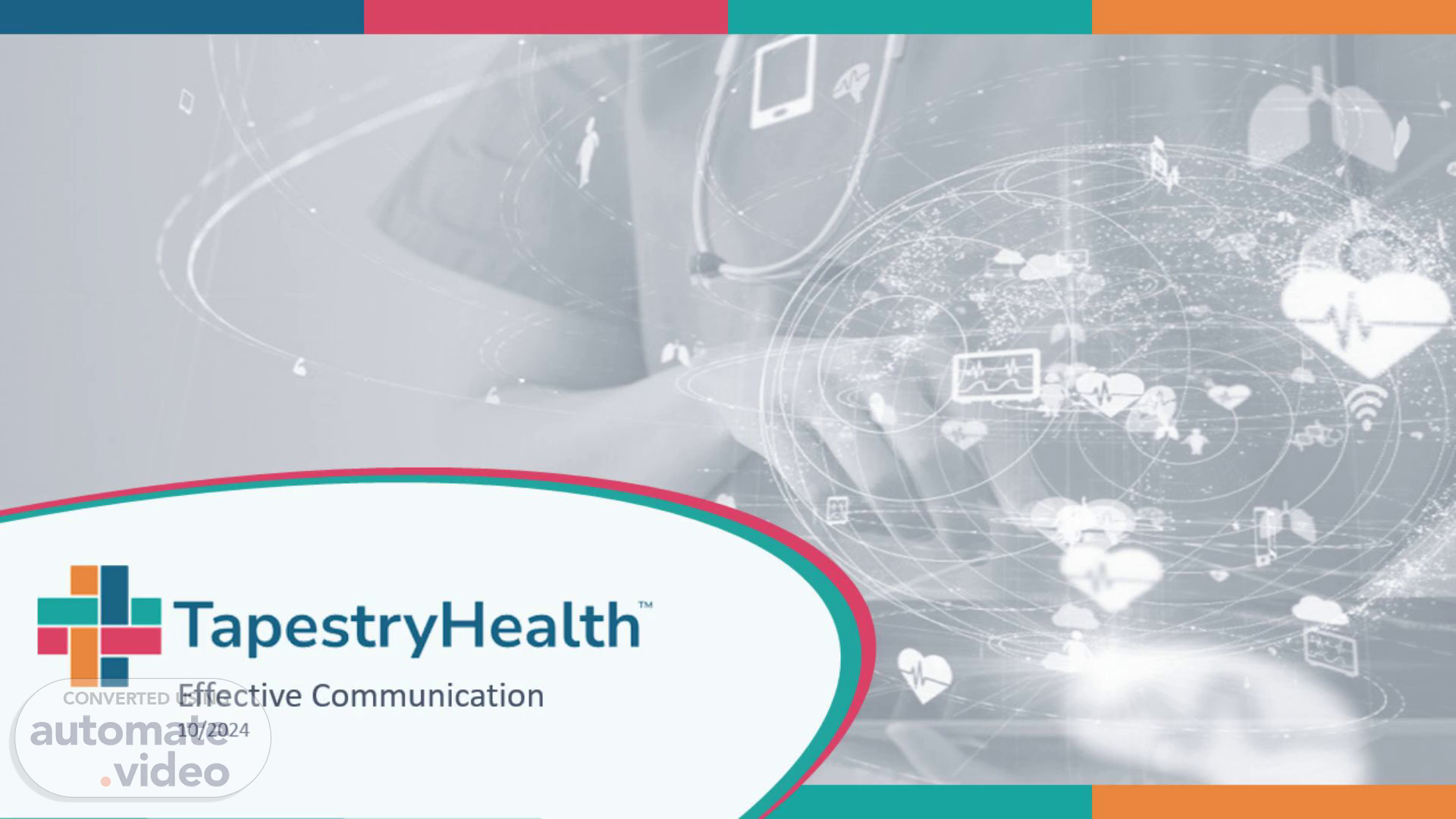Scene 1 (0s)
10/2024. Effective Communication.
Scene 2 (6s)
During this training we will cover Understand the key components of effective communication. Learn how to tailor communication styles based on the audience and context. Improve active listening, verbal, and written communication skills. Address barriers to communication and develop strategies to overcome them..
Scene 3 (22s)
What is Communication? Definition: The process of exchanging information, thoughts, and ideas through various methods (verbal, non-verbal, written). Types of communication: Verbal: Face-to-face conversations, phone calls. Non-verbal: Body language, facial expressions, tone of voice. Written: Emails, reports, messaging apps. Why is Effective Communication Important? Fosters collaboration and teamwork. Reduces misunderstandings. Enhances problem-solving and decision-making..
Scene 4 (44s)
Example 1: Types of Communication Verbal: During a team meeting, a manager discusses project deadlines and expectations with the group. Non-verbal: While explaining a complex concept, a team member uses hand gestures and facial expressions to emphasize key points. Written: A team leader sends a detailed email outlining tasks for the week with clear instructions and deadlines. Example 2: Importance of Communication A miscommunication during a client presentation leads to incorrect data being shown, resulting in a loss of trust. Clearer communication could have prevented the issue..
Scene 5 (1m 8s)
The Importance of Active Listening Helps build trust and rapport. Ensures you understand the message fully before responding. Key Techniques for Active Listening: Pay attention: Be fully present in the conversation. Show that you’re listening: Nod, make eye contact, and give verbal acknowledgments. Provide feedback: Summarize what the speaker has said and ask clarifying questions. Avoid interrupting: Allow the speaker to finish their thoughts..
Scene 6 (1m 29s)
Example 1: Active Listening in Action During a one-on-one meeting, an employee is explaining a challenge they’re facing. The manager listens attentively without interrupting, occasionally nodding and paraphrasing to confirm understanding: “So, if I’m hearing correctly, the main issue is the delay in receiving the reports, right?” Example 2: The Impact of Not Listening A colleague quickly responds to a message before reading it thoroughly. This leads to confusion as their reply doesn't address the actual problem being raised..
Scene 7 (1m 53s)
Speaking Clearly and Concisely Use simple language that your audience can easily understand. Avoid jargon or complex terms unless necessary. Structure your message: Introduction, body, conclusion. Tailoring Your Message to the Audience Consider who you are speaking to (team members, clients, managers). Adjust your tone and level of detail based on their needs and expectations..
Scene 8 (2m 12s)
Example 1: Speaking Clearly and Concisely In a presentation, instead of saying: “So, basically, what I’m trying to say here is that we could maybe try to improve our customer service process because, you know, it’s important,” Say: “We need to improve our customer service process to increase satisfaction and retention.” Example 2: Tailoring the Message to the Audience When speaking to a technical team: “We need to optimize the server response time by reducing latency.” When speaking to the client: “We’re working on making the website load faster to improve the user experience.”.
Scene 9 (2m 39s)
Key Elements of Effective Written Communication Clarity: Be specific and avoid ambiguity. Tone: Keep the tone professional and appropriate for the context. Brevity: Be concise and to the point, while still covering all necessary details. Common Written Communication Tools in the Workplace Email, reports, messaging platforms like Slack or Teams. Best practices for email: Proper subject lines, concise body, clear calls to action..
Scene 10 (3m 1s)
Example 1: Clarity in Written Communication Instead of writing: “Please send me the report soon,” Write: “Please send me the sales report by 3 PM on Wednesday, October 4th.” Example 2: Tone in Written Communication An email to a colleague: “Hey, can you get that report to me ASAP?” A more professional tone: “Could you please send me the report by the end of the day? Let me know if you need more time.” Example 3: Brevity in Written Communication Instead of: “I wanted to check in to see if you’ve had a chance to go over the documents, I sent a few days ago and if you could provide me with feedback whenever you’re available,” Write: “Have you had a chance to review the documents I sent? Please provide feedback at your earliest convenience.”.
Scene 11 (3m 36s)
Common Barriers to Communication: Language differences, cultural differences, personal biases, emotional barriers. Miscommunication due to unclear messages or lack of feedback. Strategies to Overcome Communication Barriers: Be mindful of language and cultural differences. Check for understanding by asking questions. Practice empathy and be patient in your communication..
Scene 12 (3m 54s)
Example 1: Language Barrier Scenario: A multinational team is collaborating, but some members are not fluent in English. To overcome this, they agree to use simple language, visual aids, and clarify any jargon used during the discussion. Example 2: Emotional Barrier Scenario: During a performance review, an employee becomes defensive. To overcome this, the manager uses empathetic language and gives the employee time to process the feedback before continuing. Example 3: Cultural Barrier Scenario: In some cultures, direct feedback is seen as rude, while in others, it's considered efficient. The team leader balances cultural sensitivities by giving constructive feedback in a way that’s respectful yet clear..
Scene 13 (4m 24s)
Practical Applications in the Workplace Apply the skills learned to day-to-day communication with colleagues, clients, and managers. Use feedback loops to continuously improve communication. Building a Culture of Open Communication Encourage transparency and openness within the team. Lead by example: Show active listening, provide constructive feedback, and maintain open channels of communication..
Scene 14 (4m 43s)
Session 6: Putting It All Together Example 1: Practical Application in the Workplace After the training, a team member starts applying active listening skills during meetings, leading to fewer misunderstandings and improved collaboration. Example 2: Building a Culture of Open Communication A company introduces monthly feedback sessions where team members can openly discuss any concerns or suggestions for improvement, fostering a more transparent workplace environment..
